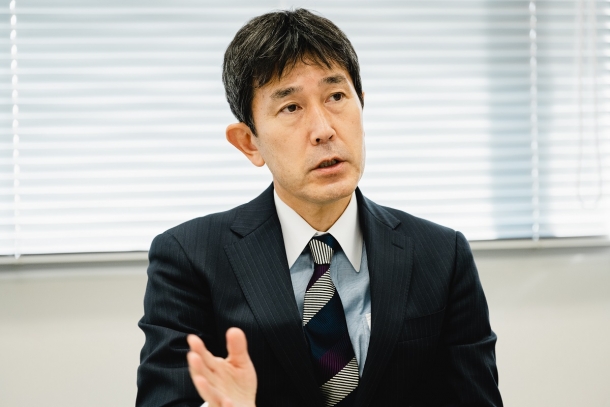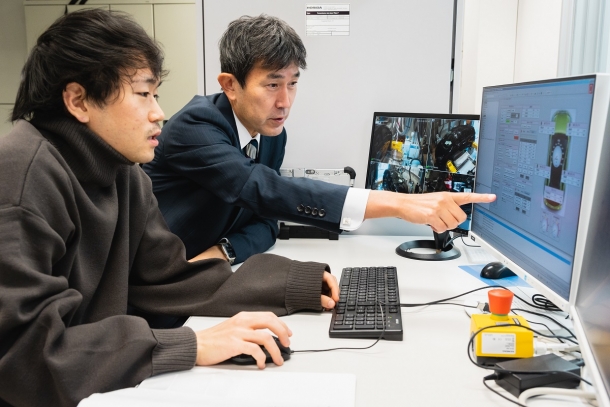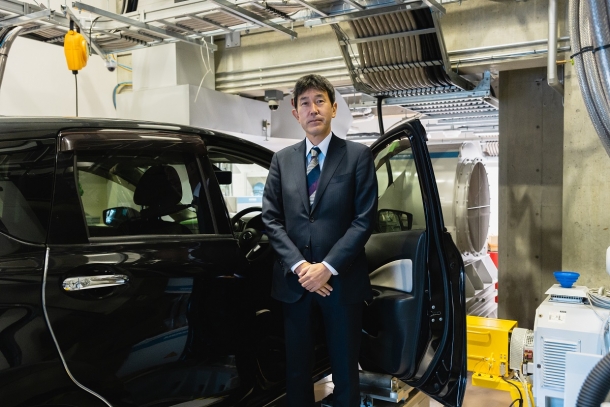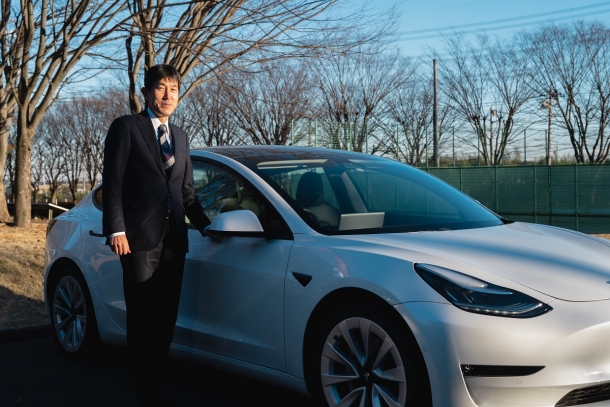- その他
- カーボンニュートラルの実現に向けた研究・開発に邁進 / Pushing Ahead with Research and Development to Achieve Carbon Neutrality【創造理工学部 総合機械工学科・草鹿仁教授】
カーボンニュートラルの実現に向けた研究・開発に邁進 / Pushing Ahead with Research and Development to Achieve Carbon Neutrality【創造理工学部 総合機械工学科・草鹿仁教授】

- Posted
- 2023年3月9日(木)

エンジンから触媒、電池へと広がる自動車用パワートレイン研究
環境問題やエネルギー問題などを背景に、電気自動車の普及が進んでいる。EU(欧州連合)はガソリン車の新車販売を2035年に禁止することを決定。ガソリン車から電気自動車へシフトしていくことが予想されるが、創造理工学部総合機械工学科の草鹿仁教授は別の見方をする。
「中国やアジアの後、自動車販売の主戦場はアフリカになります。そこで資源価格の高騰で益々高価になる電気自動車が売れるのか、相当厳しいと思います」(草鹿教授)
現在、再生可能エネルギーから作られるe-fuelという液体燃料の研究が進んでいる。実は、2035年のガソリン車の新車販売禁止には条件があり、2026年にe-fuelの研究成果を見てから最終決定することになっている。そのため、e-fuel次第でハイブリッド車などは残る可能性が大いにある。
「電動化の難しい大型トラック用のエンジンや、定置式や船のエンジンもなくならないでしょう。もちろん、燃料は水素、アンモニア、メタノールなど、カーボンニュートラルなものになりますが、すべてが電気になることはないです。」(草鹿教授)
修士課程でメタノールをディーゼルエンジンに適応する研究に取り組んだ草鹿教授。博士課程ではメタノールディーゼルエンジンを試作し、理論面ではメタノールの燃焼素反応をコンピューターで解析、燃焼特性や排出ガスの生成過程を明らかにした。1999年に研究室を構えると、リチウムイオン、電池や燃料電池、触媒にも研究範囲を広げ、エンジンもディーゼル、天然ガス、ガソリンと幅広く研究してきた。
「いろいろなことをやってますね、とよく言われます。でも、熱エネルギーの変換過程の化学反応と熱流体をカップリングさせるという意味では、エンジンも電池も触媒も変わりません。キーワードは『化学反応』です。エンジンは、燃料と酸素が輸送されて化学反応が起こる。リチウムイオン電池は、リチウムイオンが電池の中で輸送されて、電極で化学反応が起こる。触媒なら、触媒表面に運ばれてきた物質が化学反応で浄化される。基本的には化学物質と熱と流れを一緒に解いていく、ただそれだけです」(草鹿教授)

車両開発の共通基盤を構築
現在、草鹿教授が取り組んでいるのが、2020年に導入した4軸シャシダイナモメーターを使った研究だ。これは室内で自動車を固定したまま4輪を独立して回転させ実際の走行状態を再現できる装置で、日本の大学としては唯一の施設。この装置を使って自動車のエンジン、触媒やバッテリー、モーター・インバーターなどの特性をモデル化し、走行性能や排出ガスを予測する車両モデルの研究を行っている。
「モデルベース開発に活用できる車両モデルを、経済産業省のSURIAWASE2.0をプラットフォームに構築しています。自動車メーカーから、Tier1やTier2といったサプライヤー企業まで使っていけば、共通の言語で自分たちが作った製品を車載したときのベンチマークができるようになり、日本企業の開発力や国際競争力の向上も期待できます」(草鹿教授)
水素やアンモニアといった、すでにスタートしているカーボンニュートラルな新燃料の研究に加えて、2021年からはe-fuelの研究も始まった。e-fuelはdrop-in燃料やカーボンリサイクル燃料とも呼ばれている。ガソリンや軽油と組成が近く、ガソリンに混ぜたり、既存のガソリンスタンドの設備を使ったりすることが可能だ。
「エンジンや触媒の研究は、水素やアンモニア、e-fuelなどの新燃料に関するものに変わってきました。まだ燃焼特性や排出ガス特性が明らかではないので、研究を進めています」(草鹿教授)

2050年カーボンニュートラルに向けて
今後は、4軸シャシダイナモメーターを使った電気自動車のモデル化に加えて、冷却回路の設計や熱制御の研究にも力を入れていくという草鹿教授。空調機器と組み合わせた熱制御の研究では、4軸シャシダイナモメーターを使うことで実車走行時のデータを得られることが強みとなる。
「我々は機械系なので、モーターを効率的に冷やし回生エネルギー量を多くしたり、バッテリーの熱を暖房に利用したりして、航続距離を1kmでも長くしたい。そういった研究はこれから盛んになると思いますし、実際、ニーズがすごく多いです」(草鹿教授)
2020年10月、国は2050年カーボンニュートラルを目指すことを宣言。そんな中、草鹿教授が大学院生時代に研究対象にしたメタノール燃料が、船舶用エンジンの燃料の本命として注目されている。
「一度は終息した技術が、世の中の流れに合わせて復活してくるのは面白いですね。世の中では電気自動車がホットですが、エンジンや触媒の研究も地道にやっていきます。水素やアンモニアを使った定置式や船のエンジンの研究も、2050年に向けて重要なテーマです。自動車用の触媒では、ゼロエミッションではなく、大気をよりきれいにする“ネガティブエミッション触媒”を目指しています。新しい燃料も出てきてやることは多く、昔も今も、とても忙しいですよ」(草鹿教授)
プロフィール
草鹿 仁 教授(創造理工学部 総合機械工学科)
くさか・じん/早稲田大学理工学部機械工学科を経て、97年同大学院理工学研究科博士後期課程修了。博士(工学)。早稲田大学理工学部専任講師、助教授、シャルマーズ工科大学訪問教授などを経て、2008年から現職。01年自動車技術会賞浅原賞学術奨励賞、13年計測自動制御学会論文賞、21年自動車技術会賞論文賞などを受賞。専門は熱工学、自動車用パワートレイン。
所属学会
自動車技術会、日本機械学会、計測自動制御学会、米国自動車技術会

Research on automotive powertrains, from engines to catalysts and batteries
The use of electric vehicles is increasing against the backdrop of environmental and energy issues. The European Union (EU) has decided to ban the sale of new gasoline vehicles in 2035. It is expected that there will be a shift from gasoline-powered cars to electric cars, but Professor Jin Kusaka of the Department of Modern Mechanical Engineering, School of Creative Science and Engineering, takes a different view.
“When it comes to selling cars, China and other countries in Asia have seen a lot of competition, but now the focus shifts to Africa. However, I think it is quite difficult to sell electric vehicles, which are becoming increasingly expensive due to soaring resource prices.” (Professor Kusaka)
Research is underway on e-fuel, a liquid fuel made from renewable energy. There are conditions whether to ban the sale of new Internal combustion engine vehicles in 2035, and the final decision will be made after examining the results of e-fuel research in 2026. Therefore, it is very probable that hybrid cars will remain, depending on what happens with e-fuel.
“Engines for heavy trucks, stationary engines, and ship engines, which are all difficult to make electric, will not disappear. Of course, carbon-neutral fuels like hydrogen, ammonia, and methanol will be used, but not everything will be made electric.” (Professor Kusaka)
Professor Kusaka was engaged in research on adapting methanol to diesel engines for his master’s degree. For his PhD project, he developed a prototype methanol diesel engine, theoretically analyzed the combustion elemental reaction of methanol with a computer, and clarified the combustion characteristics and the process of generating exhaust gases. Launching a laboratory in 1999, he has expanded his research into lithium-ion, batteries, fuel cells, catalysts, and various engines such as diesel, natural gas, and gasoline.
“People often tell me, ‘You’re doing many things, aren’t you?’ However, there is no difference between engines, batteries, and catalysts in coupling thermal fluids with chemical reactions when converting thermal energy. The key word is ‘chemical reaction.’ In an engine, fuel, and oxygen are transported to create a chemical reaction. In a lithium-ion battery, lithium ions are transported inside the battery, and a chemical reaction occurs at the electrodes. With a catalyst, substances carried to the catalyst’s surface are purified by a chemical reaction. Essentially, we are trying to understand how chemicals, heat, and flow react with each other.”
Building a common foundation for vehicle development
Professor Kusaka is currently working on research using a four-axis chassis dynamometer introduced in 2020. This is the only facility at a Japanese university to reproduce actual driving conditions by rotating the four wheels independently while the car is fixed indoors. Using this system, he has been developed vehicle models that predict driving performance and emissions by modeling the characteristics of automobile engines, catalysts, batteries, motor inverters, and other aspects.
“We are building vehicle models that can be used for model-based development on the SURIAWASE 2.0 platform of the Ministry of Economy, Trade and Industry. Suppose they are used by not only car manufacturers but also Tier 1 and Tier 2 suppliers. In that case, we can benchmark the products created in a language we understand when installed in vehicles, which is expected to improve the development capabilities and international competitiveness of Japanese companies.”
In addition to existing research on new carbon-neutral fuels, such as hydrogen and ammonia, research on e-fuel began in 2021. E-fuel is also known as drop-in fuel or carbon-recycled fuel. Since it is similar to gasoline and diesel in composition, it can be mixed with gasoline or used with equipment at existing gas stations.
“Research on conventional fuel engines and catalysts has shifted to new fuels such as hydrogen, ammonia, and e-fuel. Since the characteristics of combustion and exhaust gas are not yet clear, we have been conducting research on them.”
Towards carbon neutrality by 2050
In addition to modeling electric vehicles using a four-axis chassis dynamometer, Professor Kusaka plans to focus on cooling circuit design and thermal control research. In research on thermal control in combination with air conditioning equipment, the advantage of using a 4-axis chassis dynamometer is that data can be obtained during actual driving.
“Since we are in the mechanical engineering field, we want to increase the cruising distance by as much as 1 km by efficiently cooling the motor, increasing the regenerative energy, and using the heat from the battery for heaters. I think such research will become more popular in the future, and there has been a growing demand for it.” (Professor Kusaka)
In October 2020, the Japanese government declared its goal of achieving carbon neutrality by 2050. Meanwhile, methanol fuel, which Professor Kusaka researched as a graduate student, is attracting attention as the main fuel for marine engines.
“It’s interesting that technology that once ceased is revived in line with the world’s trends. Electric vehicles are very popular worldwide, but we will continue toresearch engines and catalysts. Research on stationary and ship engines using hydrogen and ammonia is also important for 2050. For automotive catalysts, rather than aiming for zero emissions, we aim to achieve a “negative emission catalyst” that makes the atmosphere cleaner and clearer. A lot of work needs to be done due to the emerging new fuels, and I am and have always been very busy.” (Professor Kusaka)
Profile
Professor Jin Kusaka (Department of Modern Mechanical Engineering, School of Creative Science and Engineering)
Jin Kusaka received a Doctor of Engineering degree in 1997 from the Department of Mechanical Engineering, Faculty of Science and Engineering, Waseda University. He served as an Assistant Professor and Associate Professor before becoming a full professor in 2008 in the same Faculty. He was an Invited Professor from 2005-2006 at the Chalmers University of Technology, Sweden. He received numerous awards, such as the Asahara Science Award (2001), the Outstanding Technical Paper Award (2009) from the Japan Society of Automotive Engineers (JSAE), the Technical Paper Award from the Society of Instrument and Control Engineers (SICE) in 2013 and more. He specializes in thermal energy, electromobility, and automotive propulsion system engineering.
The Affiliate Society
The Society of Automotive Engineers of Japan (JSAE), the Japan Society of Mechanical Engineers (JSME), the Society of Instrument and Control Engineers (SICE), SAE International.
- Tags
- 研究活動
